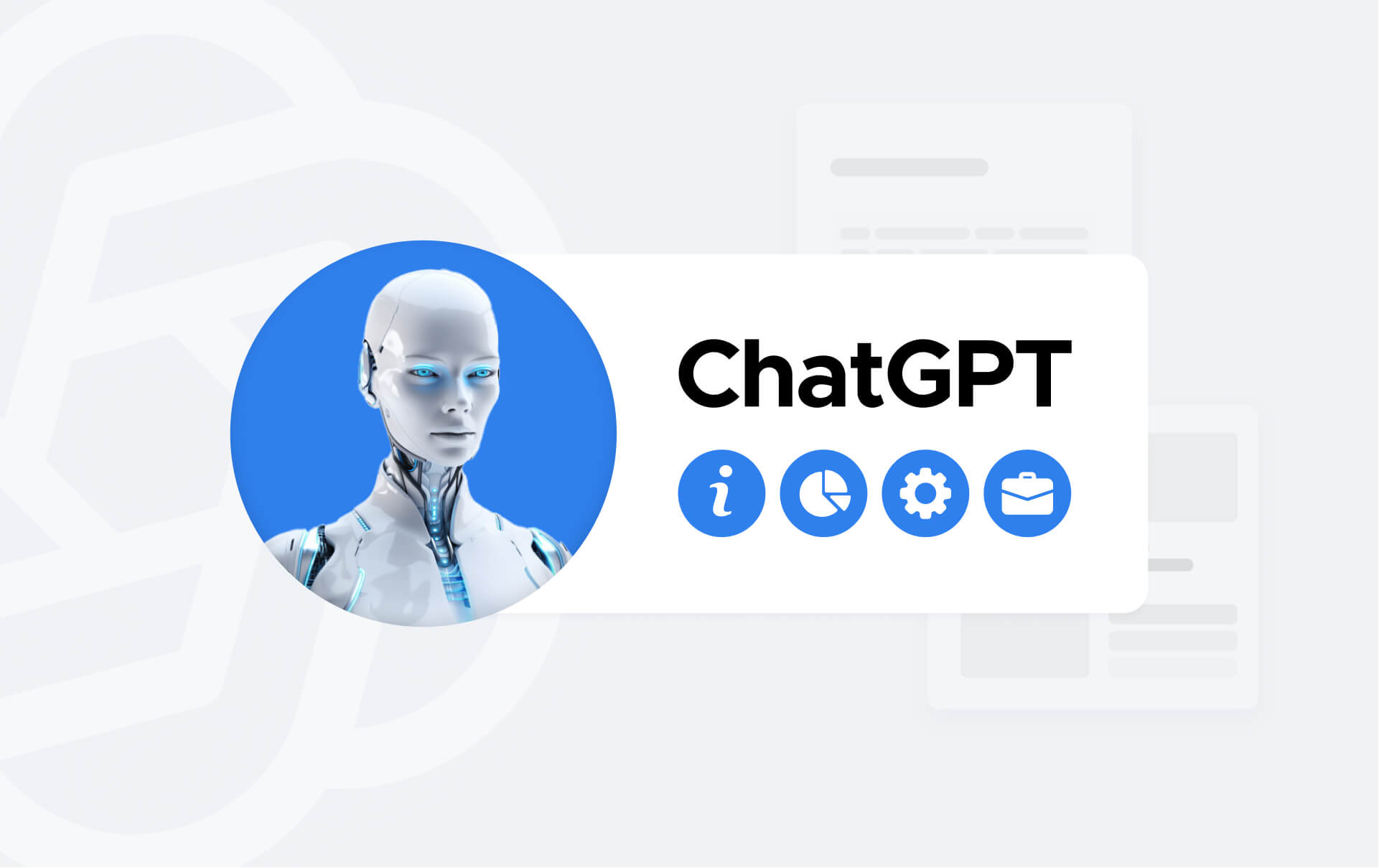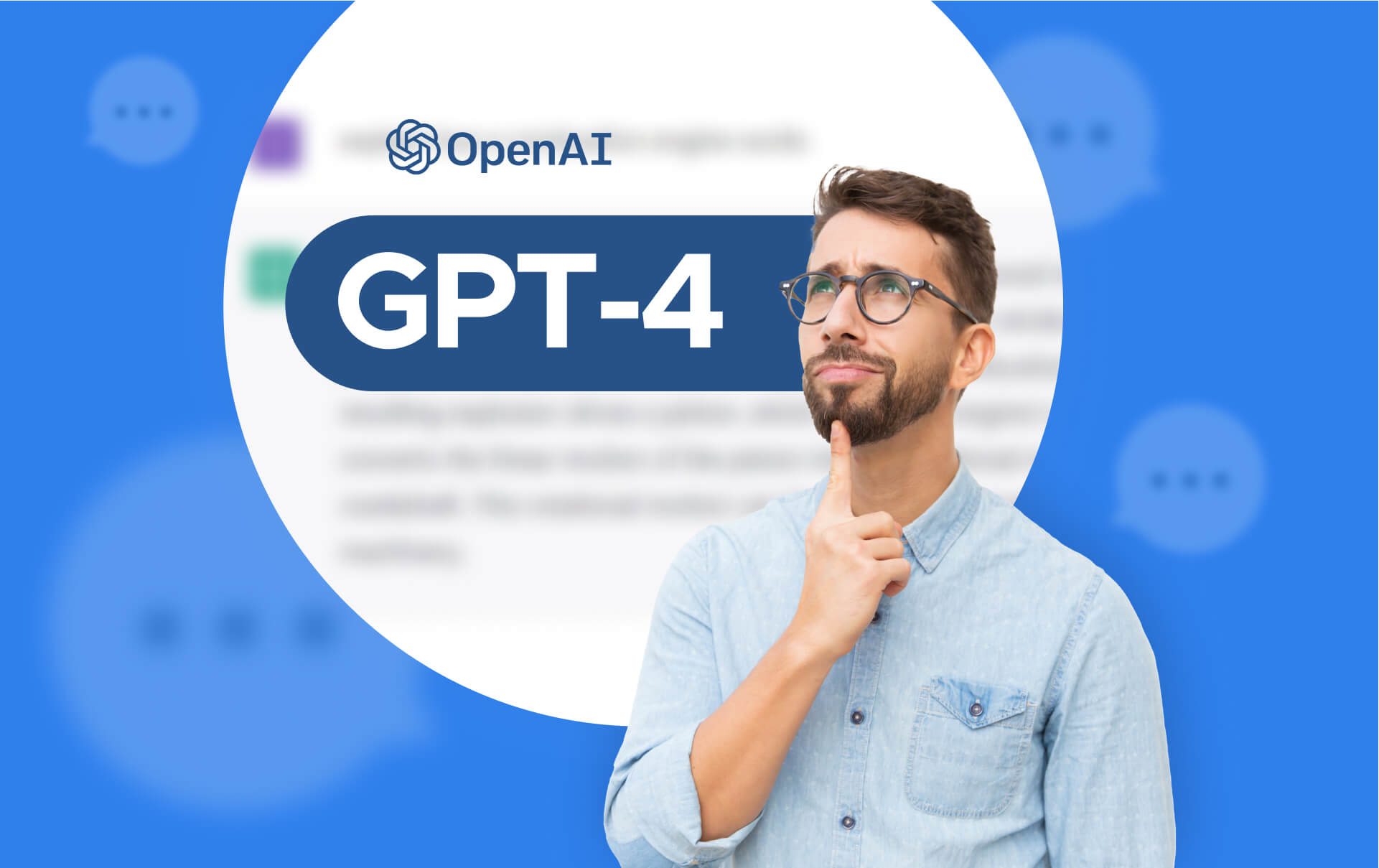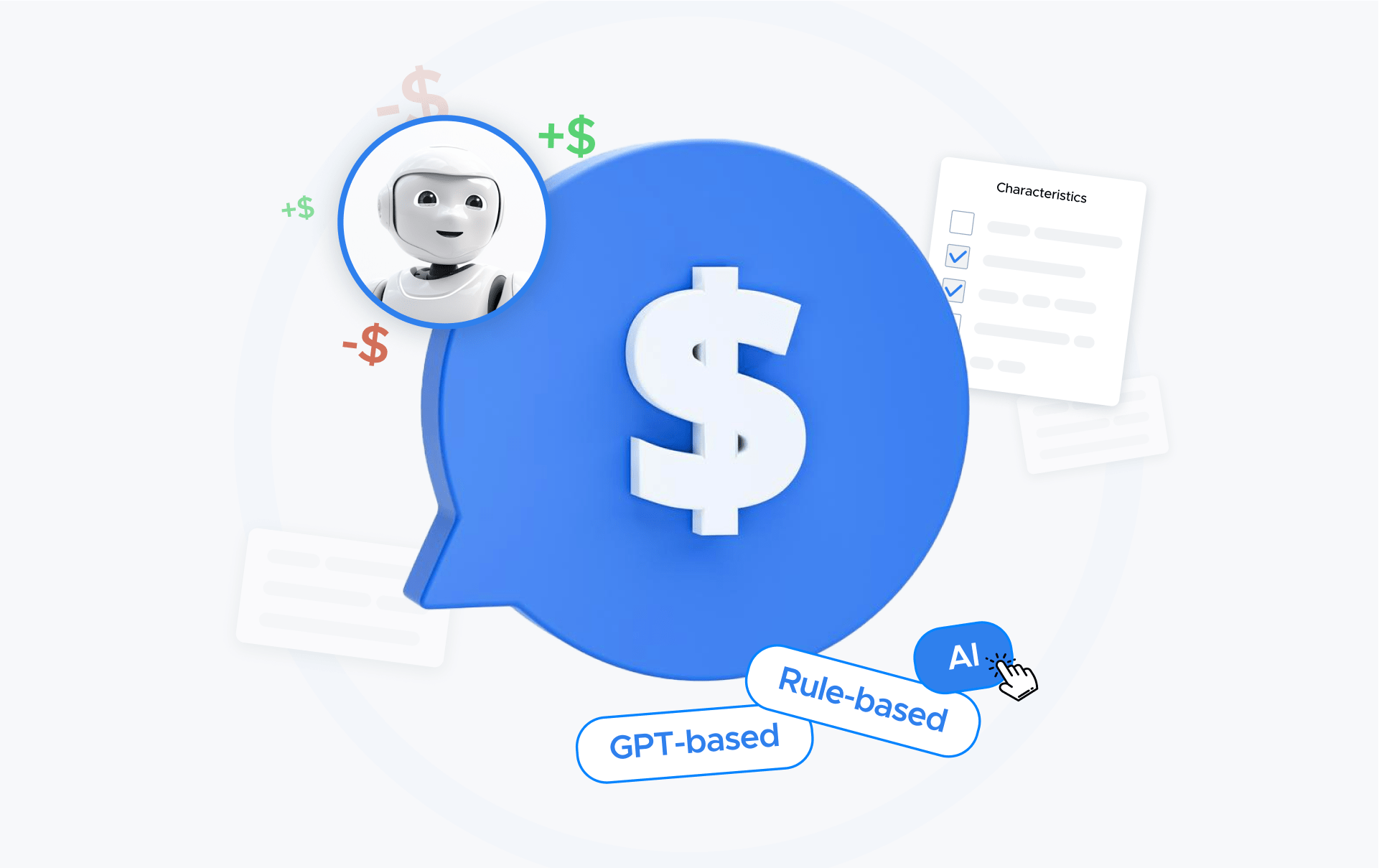Chatbots for Lead Generation: How They Qualify Leads
A lead generation chatbot can double website conversions with engaging conversations. Learn why and how to build a lead generation chatbot.
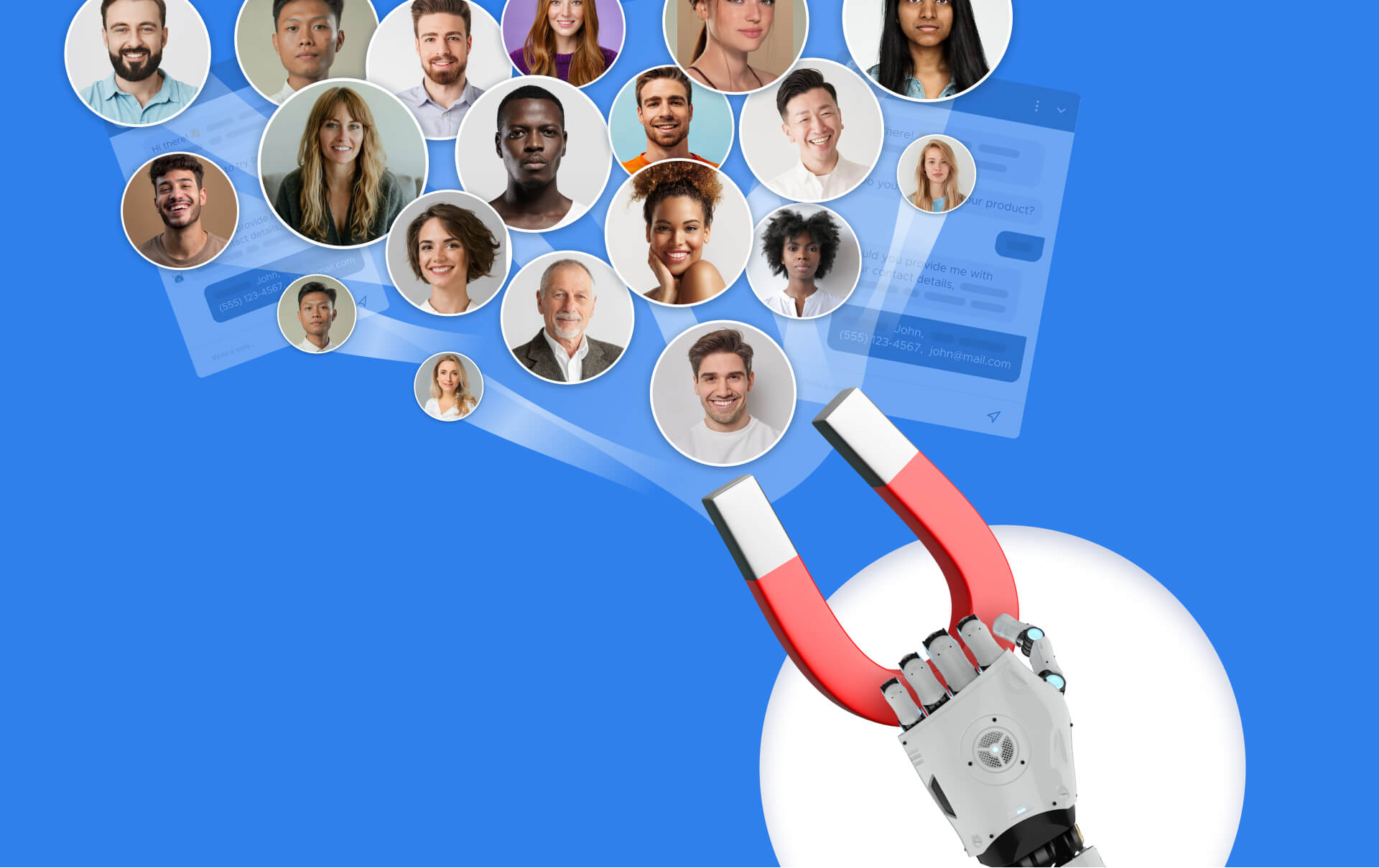
What is a Lead Generation Chatbot?
Lead generation chatbot is a tool designed to capture and qualify potential leads for a business. Its primary purpose is to engage with website visitors or users and identify individuals or organizations who are interested in a product, service, or information related to the business.
With a proper set up, AI chatbots won’t just collect user information like website forms but also investigate and nurture the interest via communication. For example, AI-powered chatbots can ask qualifying questions, recommend products or services, and more.
Overall, chatbot for lead generation typically have the following features:

Thanks to the recent advancements in AI, namely the arrival of GPT chatbots, smart and easy-to-train AI chatbots are no longer a luxury. However, any technology needs guidance to match human needs.
Let’s find out how to design a chatbot for lead generation that actually works.
Contents
How Do Chatbots Qualify Leads?
First of all, chatbots turn the contact point into an engagement hub.
Chatbots engage visitors in real-time conversations, making the user experience more interactive and personalized. Unlike static forms, chatbots can ask follow-up questions and adapt based on user responses, leading to more detailed lead qualification.
How does that help to boost lead generation? Chatbots support the lead qualification process during the conversation, and if a user meets the business's criteria, they can be immediately routed to a sales representative or provided with converting offers.
Also, with a good setup, a bot will suggest appropriate CTAs or products/services at the best moment – without human intervention. That will not only help the user and increase the chances of conversion but also provide the business with valuable insights into what users actually look for.
As a result, a chatbot tuned for lead generation will provide conversions like this one:
Source: Noform.ai
Secondly, chatbots simplify the user journey by meeting the intent on the spot.
This way, the user gets to the point faster without unnecessary steps. Did you know that about 73% of users typically drop the chat window after a welcome message if their need isn’t covered?
Lead generation chatbots can provide instant responses to website visitors. Let’s say, they want to learn how the delivery works, or ask questions about a product.The user won’t need to scroll through the pages or wait for support to answer if a trained chatbot is there to answer. This immediate interaction can significantly impact user satisfaction and lead conversion.
In addition, live assistance may support the lead qualification process. Users may not even notice the qualifying questions when a chatbot covers their needs, saves their time, and entertains them.
As a result, chatbots increase conversion rates.
Compared to traditional lead generation tools like website forms, smart chatbots guide users through the lead capture process, which can reduce abandonment rates and increase the likelihood of users completing the lead generation process. After a helpful chat, users may be more willing to provide information in a conversational format than in a traditional form, resulting in higher conversion rates.
For example, take a look at how the lead generation funnel may look like if supported with smart chatbot for lead generation:
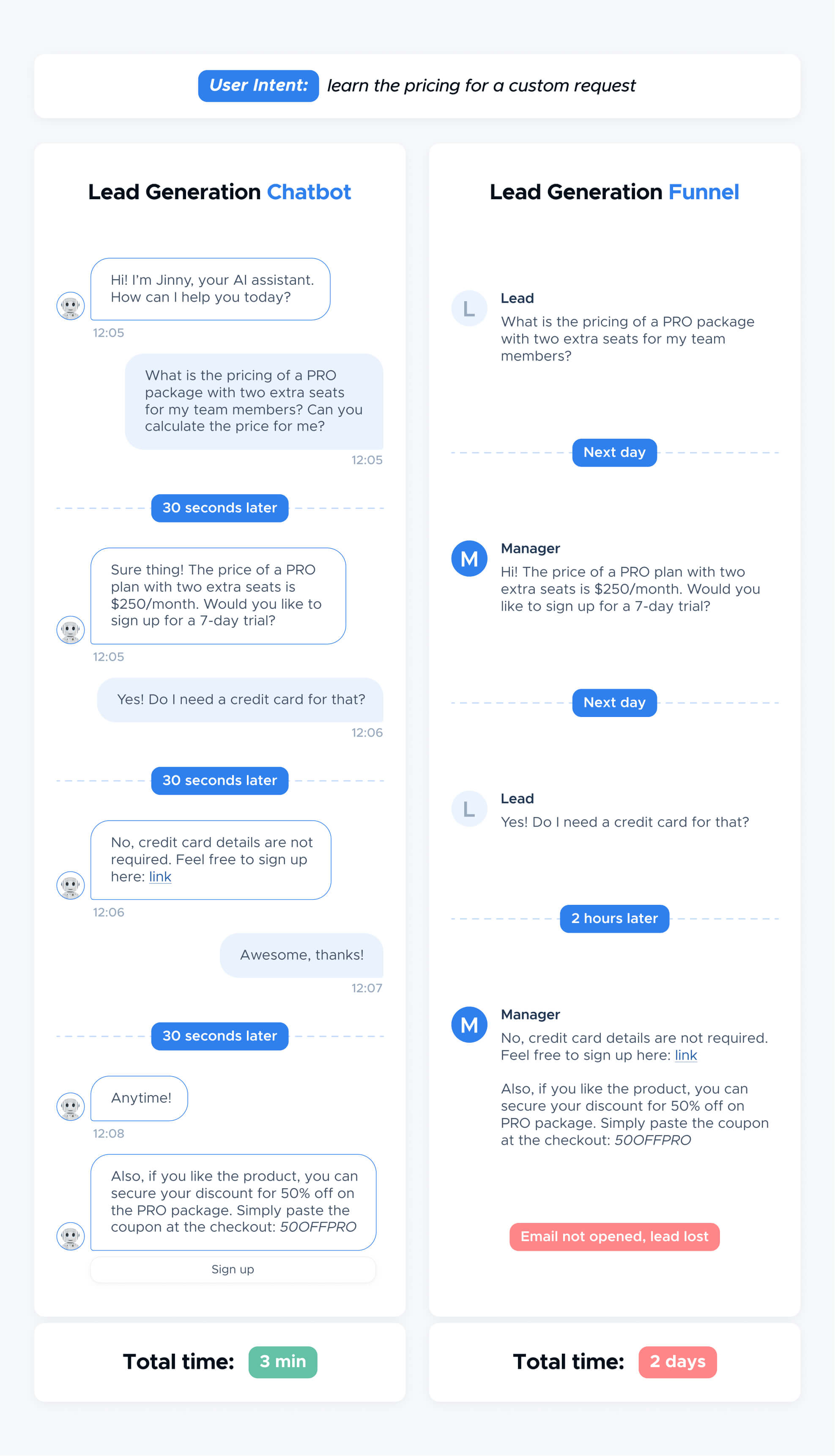
Overall, chatbots offer a dynamic, personalized, and interactive approach to lead generation and qualification, which can result in higher conversion rates and more effective data capture compared to traditional website forms.
Yet, it's important to maintain a balance between gathering the necessary information and not overwhelming potential leads with too many questions. This could discourage users from providing their details or even considering the business.
There are a few tactics to make a chatbot even more effective for lead generation.
4 Tips for Effective Lead Generation Chatbots
Below are some examples of how chatbots can collect data while staying engaging and natural to a visitor.
Provide quick choices
Below are some examples of how chatbots can collect data while staying engaging and natural to a visitor.
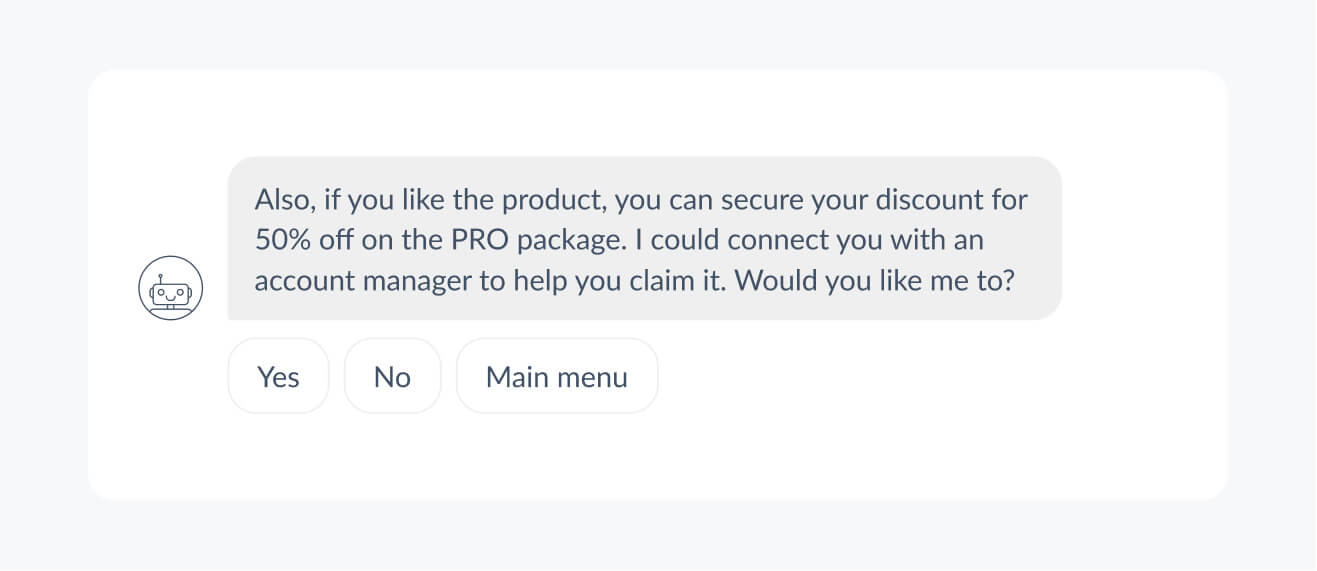
Chatbots have many conversational design elements that make the chat faster and more convenient.
By using buttons, chatbots can assess the visitor's intent with questions like, "Are you looking for information, exploring options, or ready to book a consultation?". One-click, and the user moves forward, while the business determines where they are in the sales funnel.
Calculate pricing

Pricing and budget-related questions indicate that the user is in the consideration stage. A chatbot can have a defined strategy for this kind of questions to increase the chance of conversion.
This feature is especially useful for businesses that have flexible pricing, like B2B or SaaS businesses.
For example, to help make the buying process faster, a bot could have a predefined cost calculator for specific requests. So whenever a visitor asks about the specifics of a plan, a chatbot would answer these in seconds. For advanced calculations, a bot can ask for an email in return. This way, the user gets an answer immediately, while the business catches contact details and budget information.
Offer quizzes

Quizzes are interactive and fun, making them more engaging than static content like articles or forms. Users are more likely to participate in a quiz, which can increase their time spent on your website or social media platform.
A chatbot could have a defined flow with quiz questions that will introduce your brand, educate potential leads about products or services, and make the user’s experience memorable. For example, a quiz can create a personalized offer for a visitor that would be hard to resist.
From the lead qualification perspective, you can determine the level of interest and readiness to purchase depending on the quiz questions and results. This helps prioritize and focus your sales and marketing efforts on the most qualified leads.
Suggest relevant CTAs

While answering user questions, the chatbot can keep the conversation going with highly relevant calls to action that complement the buying journey.
For ToFu (top of the funnel) leads who aren't quite ready to purchase, chatbots can offer to subscribe to newsletters or provide educational resources to nurture the leads over time.
For MoFu (middle of the funnel) leads who seek to better understand your offers a chatbot can offer product/service recommendations that fit their needs best, or explain the difference between some of the products or services.
For visitors in the BoFu (bottom of the funnel) stage who are potential buyers a bot can offer discounts, links to sign up, or book a demo option to keep the sales process going.
These were some examples of how chatbots qualify leads.
How to Build a Chatbot for Lead Generation and Qualification
So, how to make this lead generation chatbot real?
You'll need to start with your own list of chatbot requirements. The scope for lead generation depends on the business goals, budget, and required integrations. The more complex the project, the higher are the chances you may need a chatbot company to help you out with the process.
If you’re looking for guidance in building custom chatbots, check out these resources:
However, with the introduction of GPT chatbots, building a bot for lead generation has become much faster and easier. You may not need to hire a chatbot team to build a lead generation chatbot. As ChatGPT has shown the world, the “new era” AI handles conversations in an excellent manner.
So why not use ChatGPT for lead generation?
Below, we will cover the process of creating a lead generation chatbot with NoForm.AI. It’s a GPT-4-based platform that allows building a chatbot for sales with no code and zero manual training.
For that, you will need about 30 minutes and a website where the chatbot can be embedded.
Step 1: Select Data For Training

Choose the sources of information for a chatbot to refer to when generating answers. That could be website pages, knowledge base, documents (PDFs, TXTs, etc.)
Then, click “Train”. The bot will take some time to learn from the data provided.
Step 2: Customize Prompt

The prompt exists to specify for AI how you want the chatbot to behave on behalf of the company and handle the conversation. Consider this step as programming, yet, you describe instructions in simple text instead of a code.
There are multiple criteria that you can mention. The prompt can be detailed and long – so that a bot learns all the specifics from you.
Persona: Act as a sales assistant to guide visitors on the XXX platform, helping them understand the transportation services offered. Ensure to answer their queries promptly and direct them effectively to get detailed move quotes when needed.
Flow: After you’ve greeted users, collect this information step by step before {task/action}. Never ask all the questions at once, go step by step, keep it short when possible. [Specify the steps here]
Objections: Ensuring Comfort with Sharing Information:
Your trust and your safety are our top priorities. We'll only use your details to enhance your experience with [Business name]. Are you comfortable sharing?
Specific message: Closing Message (if the visitor agrees to share information):
Thank you for reaching out, [Name]! We truly care about every customer’s comfort and safety. We encourage you to get a moving quote now so we can proceed.
Step 3: Customize the Widget

Add the colors, logos, and edit widget’s appearance – everything you need for a clear brand presentation.
Step 4: Set up the welcome screen
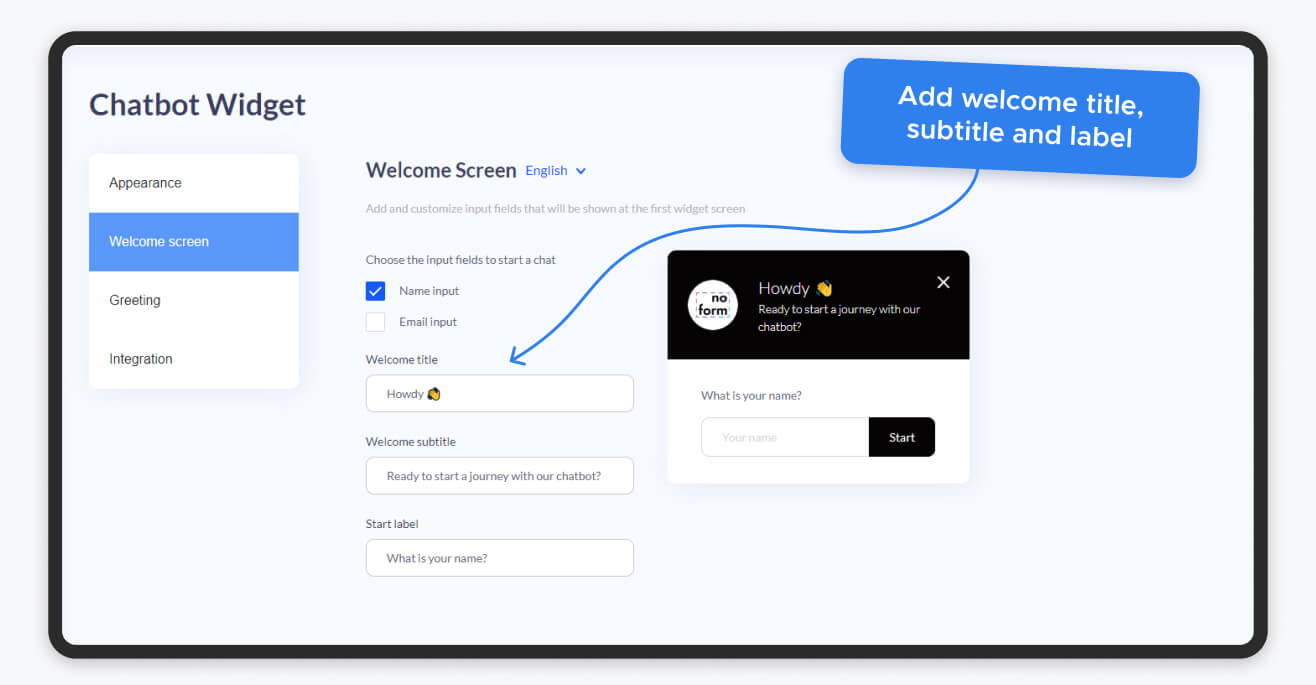
Create welcome messages and set the option for the first interaction.
Step 5: Embed on the Website
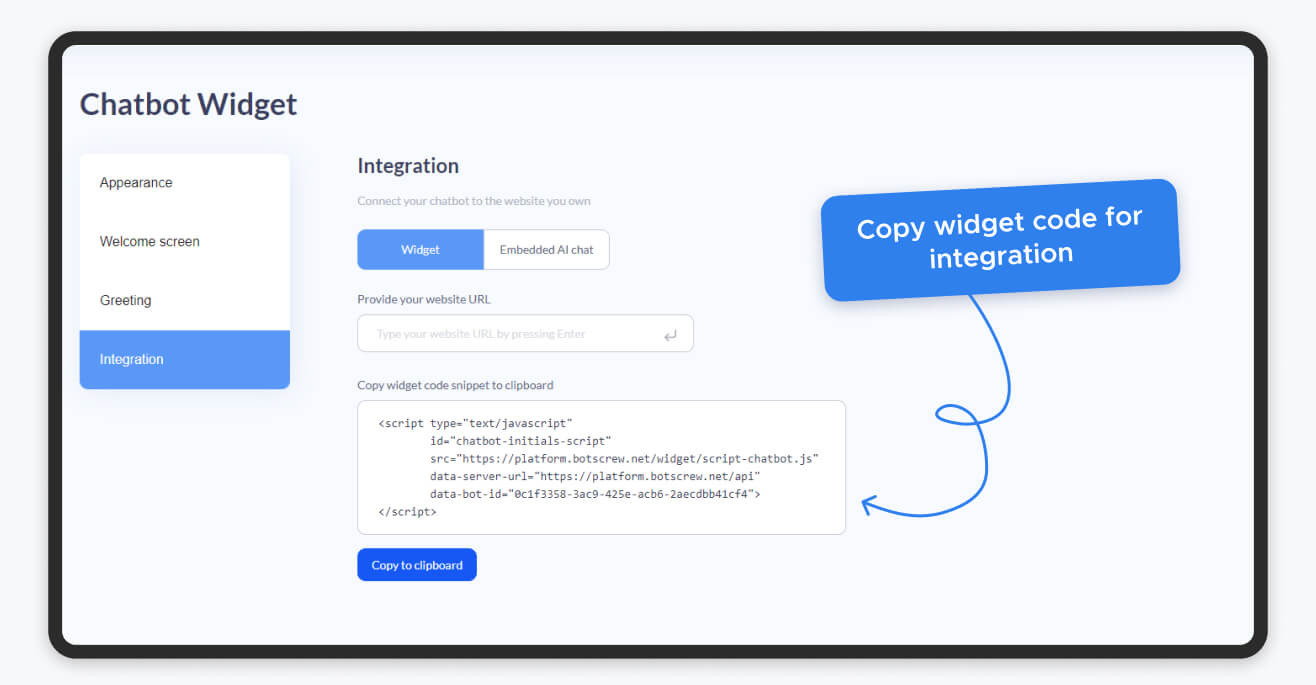
Copy the code, and embed it on the website! Your chatbot is ready to catch leads.
Bonus: Real-world Use Cases of Chatbots for Lead Generation
For the end, we prepared some use cases of successful lead generation chatbots to sparkle your inspiration. Check out how and why businesses choose to use lead-generation chatbots.
Sell More with Engagement: Virgin Holidays
Meet Cali bot – your friend that will help shake away Monday's blues by focusing on the positive and fun things that are happening in the world.
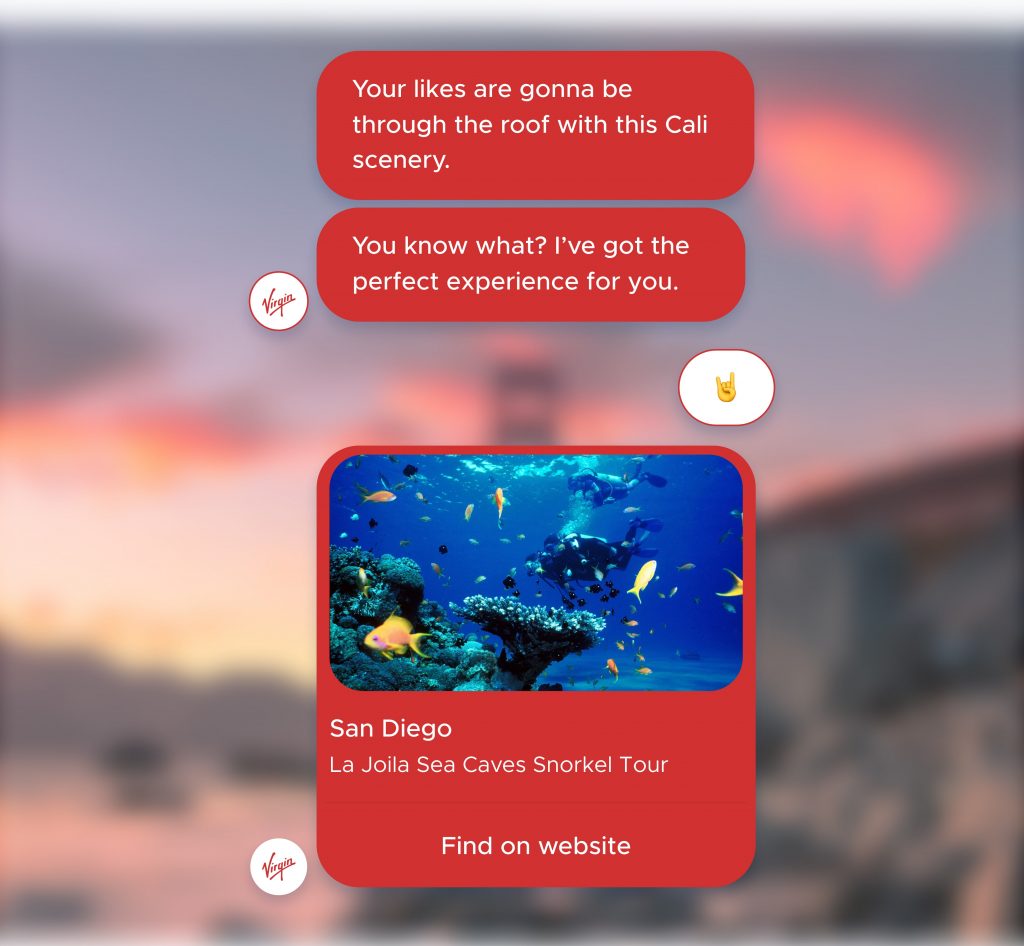
The third Monday of January is considered to be the most depressing day of the year. Virgin Holidays decided to break through this routine with a marketing campaign “Screw It, Let’s Do It”. The campaign encouraged people to look at January as the perfect month for grabbing opportunity and adventure, as Managing Director of Virgin Holidays, Joe Thompson explains.
Cali bot was designed to talk and sound like a true Californian with its common slang words, expressions, and optimistic vibe. Why Californian? With its marvelous beaches, hills, optimistic vibes, and a bunch of amazing activities, sunny California is a perfect place to visit in January.
Overall, it offered an engaging user experience and suggested buying an adventure for January.
Results
After the launch, Cali bot had massive success with the audience. In just one day, it had sold 281 travel activities. In addition, Virgin Holidays received the award for the “Screw it, Let’s do it” campaign.
Shorten the Customer Journey and Lead to 14x CR Increase
The typical research timeline for a new bike purchase spans many months. Users need an estimated 900+ digital interactions before coming to a decision. Bajaj Auto came up with a idea to use the chatbot to boost sales – and that worked incredibly well.
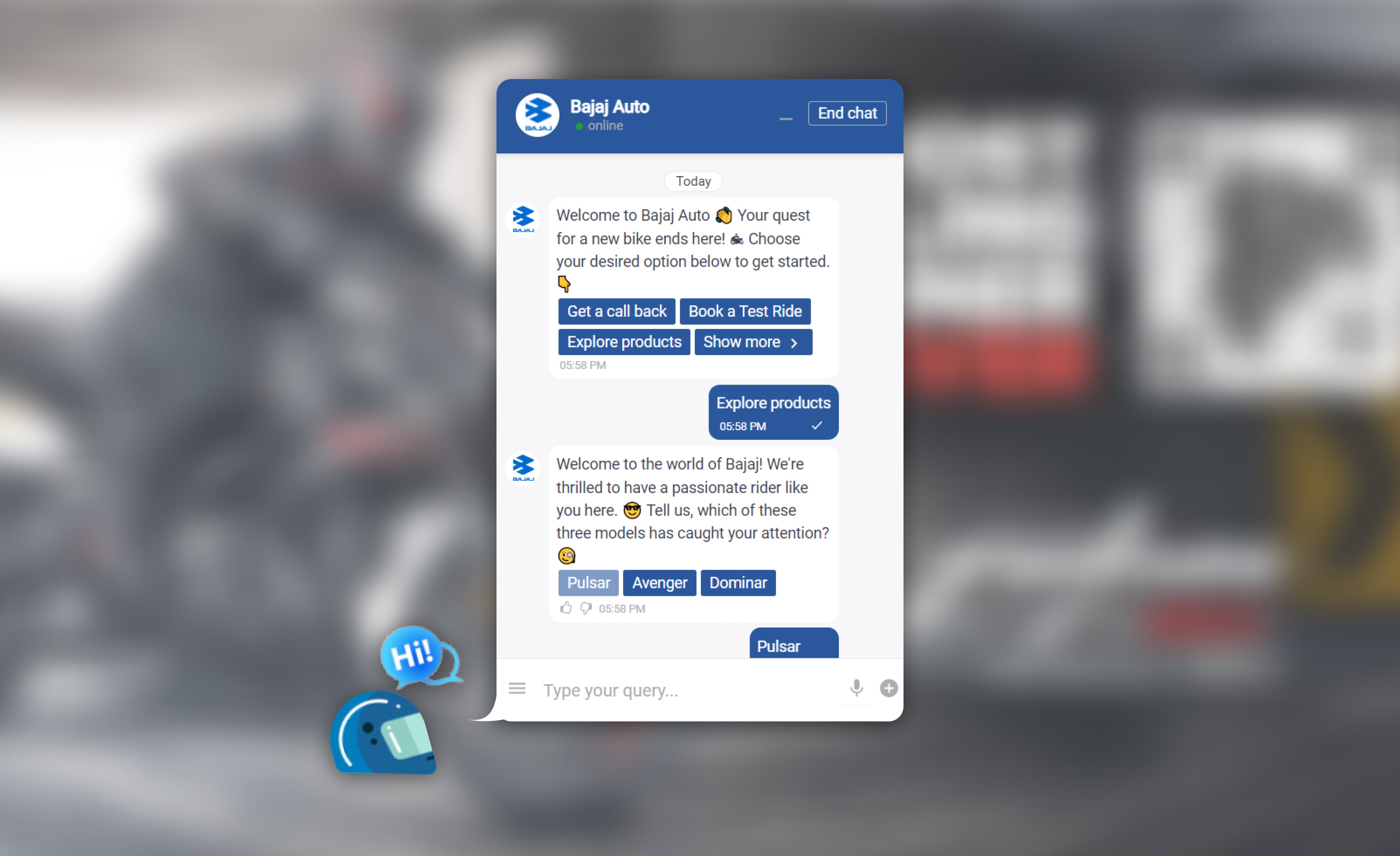
Motorbikes have a long and complex customer journey. Users seek a personalized experience that could answer their own specific questions. The company needed to develop a uniquely informative and natural experience for the audience and ultimately assist them in making a final decision.
They came up with the idea of a website chatbot with a great personality and quite an interesting visual representation that is not typical for website chatbots. With a chatbot, visitors can also book a test drive, explore products, get a call back, and find out about prices or dealers.
Bajaj Auto wanted to stand out from the competition, so they used Search Intent as the overarching measure of brand popularity when compared to their competition. With the chatbot launch, Bajaj Auto’s keywords outperformed its competition by 80%. And that was when India was thrust into COVID-19 lockdown!
Results
In the first 2 months, the chatbot talked to 34,000 unique users, and engaged in over 300 hours of automated chatbot conversation, and Bajaj Auto even saw a whopping 14.3x increase in lead conversions.







